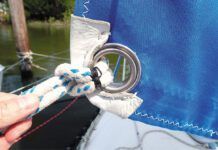
When we purposely destroyed a few boathooks during testing I saw an opportunity to make a new tiller extension for my outboard (see PS November 2016 “The Blow-by-blow Boathook Test”). I first tried this trick it was for the 18 hp Nissan on my Stiletto 27. This time it was for the 3.5 hp Mercury on my tender. The only tool required is a hack saw.
The boathook was twist-lock type and the outer tube had broken, so the extendable feature could not be preserved. I didn’t need that, anyway. Ensuring a clean cut on the exposed end where my new extender would slide over the engine’s tiller was easy. I removed the grip, cut the outer tube above the break, and slid out the inner tube.
I then covered the rough-edged cut with the original rubber hand grip, slid the pole over the tiller, and that was it. If you need a snugger fit, some athletic tape around the tiller can fill the gap.
Having a longer tiller handle is particularly useful for planing dinghies as it allows you to shift driver weight forward to help the boat plane when you are alone. One advantage of using lightweight aluminum tube over stronger material is that it will crimp before breaking the tiller handle if you accidentally apply too much downward leverage, or forcefully try to turn the engine when you’ve struck bottom (yes, we’ve seen this happen).

More multihull steering tips
On a related note, I wanted to share a few steering tips that didn’t fit into the last month’s multihull report and deserve mention (see PS February 2021 “Multihull Capsize Risk Check”). Many beach cat sailors think their skills easily translate to bigger cats, but that’s not necessarily true.
Rudders on cruising multis are much smaller in proportion to the size of the hulls and the power of the boat than on a beach cat. You won’t get the same fast, reliable response when you try to bear off after the bow begins to bury. Little rudders can’t fight poorly balanced sails. Breaking waves will further rob steering ability, so resist aggressive surfing that can overpower your rudders.
Listen to your instincts regarding trim, and practice releasing sheets from a winch. Most likely, your sheets will be belayed by self-tailing winches, and unlike your Hobie, you can’t release them with a flick of your wrist. You’ll probably need to walk across the cockpit, and then free the highly-loaded sheet from the tight grip of the self-tailer, so making this action intuitive is important.
One alternative is to install a cam cleat near the winch, and on breezy days, secure the tail there rather than in the self-tailer. You will then be able to use a familiar action to release the sheet.

Another option (our second choice) is to wrap the tail around the winch in the opposite direction after it exits the self tailing jaws. A sharp yank from across the cockpit will pull the tail out of the self-tailer. Always use a controlled release. If you let the sheet run, it can tangle, particularly if it goes through a jammer.
Drew Frye is Practical Sailor’s technical editor. He blogs at www.sail-delmarva.blogspot.com



































